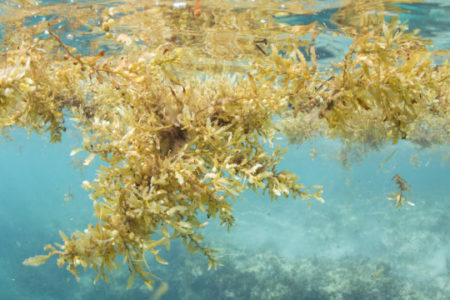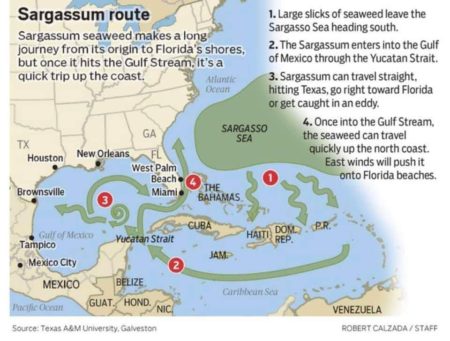July 9, 2019 – There is an area of the North Atlantic bounded by four ocean currents and described by early European navigators in search of a shortcut to the Far East as a sea unto itself that appears to be causing considerable alarm among oceanographers and scientists. Known as the Sargasso Sea, it was first described in the voyages of Christopher Columbus, as an area of free-floating seaweed called Sargassum. Unlike most seaweeds which grow from the ocean floor up, Sargassum floats and vegetatively reproduces without ever rooting anywhere. Sargassum, as described by Columbus, spread in giant floating mats across the North Atlantic and was both a nuisance and a boon to early voyagers. A nuisance because the algae slowed the ships during their Atlantic crossing, but a boon because the Sargassum served as a nursery and food source for sea life.

Bounded by ocean currents, the Sargassum occupies an area known as the Northern Atlantic Subtropical Gyre with its western boundary the Gulf Stream, northern, the North Atlantic Current, eastern, the Canary Current, and southern, the North Atlantic Equatorial Current. As you can imagine if the currents fluctuate for different reasons then the boundaries of the Sargasso Sea get equally altered.
What would cause the currents to fluctuate? Warmer than normal surface temperatures in the North Atlantic. This is a phenomenon that scientists have been observing in the North Atlantic north of the equator, the area of the ocean most commonly associated with the birth of hurricanes. So if the ocean surface is warmer and ocean currents show greater signs of oscillation, then the boundary confinement of the Sargasso Sea becomes more tenuous allowing the algae to spread.
But there is another phenomenon at play here. According to research done at the University of South Florida based on two decades of satellite data, the Amazon is playing a significant role in destabilizing the amount of Sargassum in the ocean causing the blooms to grow. What is actually happening is runoff from the Amazon is bringing fertilizer discharge into the North Atlantic Equatorial Current which is then feeding algae blooms on a massive scale outside the traditional boundaries of the Sargasso Sea.
The authors of the South Florida study call this new phenomenon the great Atlantic Sargassum Belt, and it is spreading since 2011 to cover an area from the West African coast to the Caribbean, and the Gulf of Mexico. It is over 8,850 kilometers (almost 5,500 miles) in extent, “the world’s largest macroalgal bloom” that “may become the new normal.” The estimated mass of the bloom in 2018 was 20 million tons, bigger than the previous peak volume in 2015 (see graph below), and appearing to be growing larger each year. Large volumes of Sargassum are drifting onto the shores of the Yucatan, Caribbean islands, the Florida coast, and are being picked up by the Gulf Stream and being deposited along the Carolina coast and even further north.

Other than beach despoliation, is this Sargassum mega growth a problem?
The Sargasso Sea is a giant nursery for the ocean’s tiniest inhabitants, the basis of the food chain. It provides a hatchery for shrimp, crabs, fish, turtles, and other marine species. But in excess as it drifts to shorelines it becomes a biohazard as it rots, deoxygenating the water and turning it into toxic sludge.
Add to the this, Red Tide, algae far more toxic and responsible for killing sea life on a colossal scale annually, and you have a deadly environmental feedback mechanism. Sargassum, can harbour within it Red Tide algae which when it releases its neurotoxins, even causes the host to die further contaminating shorelines and coastal waters.
The change to ocean chemistry combined with rising ocean surface temperatures is a double threat that can only be countered by changes in human behaviour. In places like Amazonia, it requires governments to restrict the use of human-created fertilizers containing nitrogen, phosphorus, and ammonia. Only then can the algal blooms begin to reduce in volume.
That doesn’t let the planet off the hook. Because other countries, not just Brazil, are equally culpable in dumping fertilizer runoff into our oceans. Just in the last week, discharge from the Mississippi River fuelled the growth of a blue-green algae known as cyanobacteria that is harmful to fish and other marine wildlife let alone humans who contact it. The Mississippi discharge was necessary to relieve flooding and high water levels further inland. So far these floodwater abatement strategies killed 48 dolphins in May and June, Compare that to the 91 known dolphin deaths in one year from the BP Deepwater Horizon spill, and you can see just how negatively significant algal blooms can become in the marine environment. The current Mississippi bloom has created a deoxygenated zone in the Gulf of Mexico that is over 20,000 square kilometers (approximately 7,829 square miles).
















